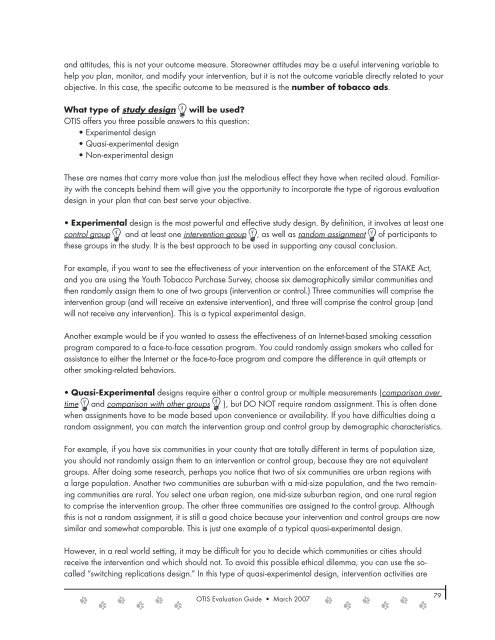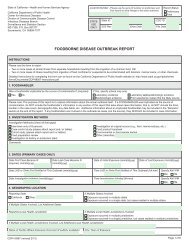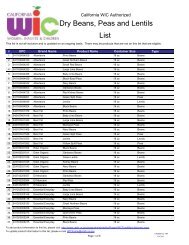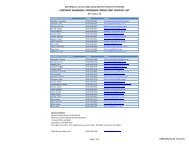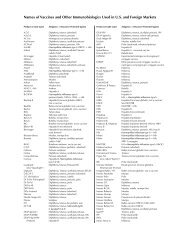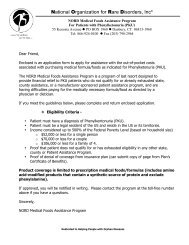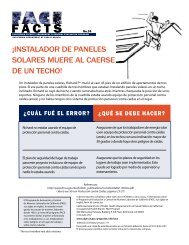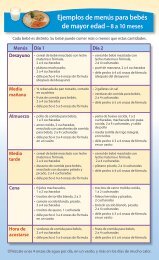OTIS Evaluation Guide (PDF) - California Department of Public Health
OTIS Evaluation Guide (PDF) - California Department of Public Health
OTIS Evaluation Guide (PDF) - California Department of Public Health
Create successful ePaper yourself
Turn your PDF publications into a flip-book with our unique Google optimized e-Paper software.
and attitudes, this is not your outcome measure. Storeowner attitudes may be a useful intervening variable to<br />
help you plan, monitor, and modify your intervention, but it is not the outcome variable directly related to your<br />
objective. In this case, the specific outcome to be measured is the number <strong>of</strong> tobacco ads.<br />
What type <strong>of</strong> study design will be used?<br />
<strong>OTIS</strong> <strong>of</strong>fers you three possible answers to this question:<br />
• Experimental design<br />
• Quasi-experimental design<br />
• Non-experimental design<br />
These are names that carry more value than just the melodious effect they have when recited aloud. Familiarity<br />
with the concepts behind them will give you the opportunity to incorporate the type <strong>of</strong> rigorous evaluation<br />
design in your plan that can best serve your objective.<br />
• Experimental design is the most powerful and effective study design. By definition, it involves at least one<br />
control group and at least one intervention group , as well as random assignment <strong>of</strong> participants to<br />
these groups in the study. It is the best approach to be used in supporting any causal conclusion.<br />
For example, if you want to see the effectiveness <strong>of</strong> your intervention on the enforcement <strong>of</strong> the STAKE Act,<br />
and you are using the Youth Tobacco Purchase Survey, choose six demographically similar communities and<br />
then randomly assign them to one <strong>of</strong> two groups (intervention or control.) Three communities will comprise the<br />
intervention group (and will receive an extensive intervention), and three will comprise the control group (and<br />
will not receive any intervention). This is a typical experimental design.<br />
Another example would be if you wanted to assess the effectiveness <strong>of</strong> an Internet-based smoking cessation<br />
program compared to a face-to-face cessation program. You could randomly assign smokers who called for<br />
assistance to either the Internet or the face-to-face program and compare the difference in quit attempts or<br />
other smoking-related behaviors.<br />
• Quasi-Experimental designs require either a control group or multiple measurements (comparison over<br />
time and comparison with other groups ), but DO NOT require random assignment. This is <strong>of</strong>ten done<br />
when assignments have to be made based upon convenience or availability. If you have difficulties doing a<br />
random assignment, you can match the intervention group and control group by demographic characteristics.<br />
For example, if you have six communities in your county that are totally different in terms <strong>of</strong> population size,<br />
you should not randomly assign them to an intervention or control group, because they are not equivalent<br />
groups. After doing some research, perhaps you notice that two <strong>of</strong> six communities are urban regions with<br />
a large population. Another two communities are suburban with a mid-size population, and the two remaining<br />
communities are rural. You select one urban region, one mid-size suburban region, and one rural region<br />
to comprise the intervention group. The other three communities are assigned to the control group. Although<br />
this is not a random assignment, it is still a good choice because your intervention and control groups are now<br />
similar and somewhat comparable. This is just one example <strong>of</strong> a typical quasi-experimental design.<br />
However, in a real world setting, it may be difficult for you to decide which communities or cities should<br />
receive the intervention and which should not. To avoid this possible ethical dilemma, you can use the socalled<br />
“switching replications design.” In this type <strong>of</strong> quasi-experimental design, intervention activities are<br />
<strong>OTIS</strong> <strong>Evaluation</strong> <strong>Guide</strong> • March 2007<br />
79


